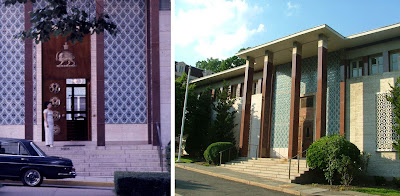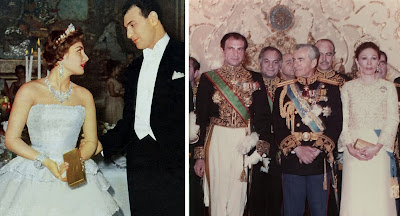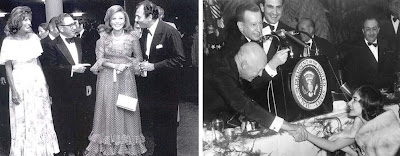
There is an unusual site that greets those driving past the 3003-3005 stretch of Massachusetts Ave., in Washington, D.C. It is there that one will find the former Iranian embassy and chancery directly adjacent to the Iranian Ambassador’s residence; a historic Georgian mansion.
The embassy building, a tall 1960’s modernist structure with an entrance framed by angular granite columns and glazed Persian tiles, has remained in a time warp since Iran shuttered its embassy in April 1980. Today its grounds and buildings are maintained by the U.S. Department of State.
 An embassy staff member waiting for guests to arrive at the main entrance to Iran’s embassy in Washington, 1969. The former Embassy of Iran as it stands today at 3003-3005 Massachusetts Ave. in Washington, D.C. The royal seal has been removed from the front entrance and most of the interiors have been stripped of their fittings.
An embassy staff member waiting for guests to arrive at the main entrance to Iran’s embassy in Washington, 1969. The former Embassy of Iran as it stands today at 3003-3005 Massachusetts Ave. in Washington, D.C. The royal seal has been removed from the front entrance and most of the interiors have been stripped of their fittings.
In January 1979, not long after the Shah and Shabanou Farah Diba flew into exile, the Iranian embassy in Washington was taken over by representatives of Ayatollah Khomeini’s regime, and has remained vacant ever since the hostage crisis. Although there have been no formal relations between the two countries since then, more intriguing perhaps is that Iran continues to own several key properties in Washington in addition to the embassy and ambassador’s residence. These include the residence of the Iranian military attaché at 3410 Garfield Street and the residence of the Iranian Minister of Cultural Affairs at 2954 Upton Street.
They are the remnants of a time when Iran’s ambassador, Ardeshir Zahedi, became one of the most influential diplomats in Washington DC; and an invitation to one of his glittering events was the most sought after ticket in town.
 Princess Shahnaz and Ambassador Zahedi on their wedding day in 1957; Ambassador Zahedi with the Shah and Shahbanou of Iran.
Princess Shahnaz and Ambassador Zahedi on their wedding day in 1957; Ambassador Zahedi with the Shah and Shahbanou of Iran.
They are the remnants of a time when Iran’s ambassador, Ardeshir Zahedi, became one of the most influential diplomats in Washington DC; and an invitation to one of his glittering events was the most sought after ticket in town.
 Princess Shahnaz and Ambassador Zahedi on their wedding day in 1957; Ambassador Zahedi with the Shah and Shahbanou of Iran.
Princess Shahnaz and Ambassador Zahedi on their wedding day in 1957; Ambassador Zahedi with the Shah and Shahbanou of Iran.
During the Seventies as oil-rich Iran was in the midst of tremendous economic and social changes, Ambassador Zahedi enjoyed the confidence of the Nixon, Ford and Carter administrations, while strengthening ties with US congressmen, journalists, civic officials and university academics; many of whom were invited to visit Iran.
Zahedi’s diplomatic career began shortly after his marriage to Princess Shahnaz, the daughter of the Shah and his first wife Princess Fawzia of Egypt. In 1959 he was appointed Ambassador to the United States, and then to the Court of St. James’s from 1962-66. But it was during his second tour of duty as Iran’s Ambassador to the United States from 1973-79, that Zahedi embarked on an ambitious plan to renovate and refurbish the interiors of both the embassy and residence; transforming them into a showcase for Iranian culture.
 Henry Kissinger and wife Nancy at a party given at the Iranian Embassy in Washington DC hosted by the Empress and Ambassador Ardeshir Zahedi, 1977; President Eisenhower greets Princess Shahnaz Pahlavi in Washington DC. Also pictured is Iranian Ambassador Ardeshir Zahedi,1960.
Henry Kissinger and wife Nancy at a party given at the Iranian Embassy in Washington DC hosted by the Empress and Ambassador Ardeshir Zahedi, 1977; President Eisenhower greets Princess Shahnaz Pahlavi in Washington DC. Also pictured is Iranian Ambassador Ardeshir Zahedi,1960.
Zahedi’s diplomatic career began shortly after his marriage to Princess Shahnaz, the daughter of the Shah and his first wife Princess Fawzia of Egypt. In 1959 he was appointed Ambassador to the United States, and then to the Court of St. James’s from 1962-66. But it was during his second tour of duty as Iran’s Ambassador to the United States from 1973-79, that Zahedi embarked on an ambitious plan to renovate and refurbish the interiors of both the embassy and residence; transforming them into a showcase for Iranian culture.
 Henry Kissinger and wife Nancy at a party given at the Iranian Embassy in Washington DC hosted by the Empress and Ambassador Ardeshir Zahedi, 1977; President Eisenhower greets Princess Shahnaz Pahlavi in Washington DC. Also pictured is Iranian Ambassador Ardeshir Zahedi,1960.
Henry Kissinger and wife Nancy at a party given at the Iranian Embassy in Washington DC hosted by the Empress and Ambassador Ardeshir Zahedi, 1977; President Eisenhower greets Princess Shahnaz Pahlavi in Washington DC. Also pictured is Iranian Ambassador Ardeshir Zahedi,1960.
To get the job done he commissioned London decorator Michael Szell, whose work he had become acquainted with during his stint at the Iranian Embassy in London. Well-known in England as a fabric designer, Szell had already decorated palaces, mansions and tents from Tehran to Persopolis. Yet although he was familiar with Iranian culture and its decorative arts, the Washington embassy provided a rare challenge for Mr. Szell. At the time (along with its counterparts in London and Paris) the Iranian Embassy in Washington was one of the most important in the world.
 The main reception room of the Ambassador’s residence and its monumental Mashad rug. The ormolu-trimmed commode and the clock resting on it are both Second Empire French; Guests at an embassy reception in 1969.
The main reception room of the Ambassador’s residence and its monumental Mashad rug. The ormolu-trimmed commode and the clock resting on it are both Second Empire French; Guests at an embassy reception in 1969.
 The main reception room of the Ambassador’s residence and its monumental Mashad rug. The ormolu-trimmed commode and the clock resting on it are both Second Empire French; Guests at an embassy reception in 1969.
The main reception room of the Ambassador’s residence and its monumental Mashad rug. The ormolu-trimmed commode and the clock resting on it are both Second Empire French; Guests at an embassy reception in 1969.
Known for being energetic, frank and detail oriented, ambassador Zahedi worked closely with Szell on every phase of the project. The result was a series of sumptuous interiors that blended Persian antiques with a mix of European furniture and contemporary fabrics. Yet the true stars of the new interior transformations were the embassy’s dazzling collection of rare Persian carpets. The most priceless amongst them represented the finest workmanship from Kerman, Isfahan, Tabriz, Qum and (the pièce de résistance) a mammoth Mashad. Placed in the main salon of the ambassador’s residence, it was originally commissioned by Shah Reza Pahlavi and once graced the floors of the Gulistan Palace in Tehran. Its unique coloration of saffron and cinnamon flowers blooming on an amethyst field made it a rarity.
 Guests reclining on low banquettes and cushions covered in traditional embroidered fabrics, enjoy a private recital in the Embassy’s Persian Room, 1969.
Guests reclining on low banquettes and cushions covered in traditional embroidered fabrics, enjoy a private recital in the Embassy’s Persian Room, 1969.
 The Persian Room, with its veritable kaleidoscope of tiny mosaic mirrors executed by an Iranian craftsman, 1969.
The Persian Room, with its veritable kaleidoscope of tiny mosaic mirrors executed by an Iranian craftsman, 1969.
Not surprisingly the ambassador worked quiet diligently at giving parties (not easily duplicated in Washington), as he did when attending to paperwork in his embassy office. Thus at formal dinners attended by the likes of Henry and Nancy Kissinger and Nelson Rockefeller, guests would be seated at tables adorned with clusters of white orchids and gardenias, 17th century silver doves, candles engraved with Persian designs and blue and white Sefavid dinner ware. Aambassador Zahedi would insist on serving the best wine and finest cuisine; passing around bowls of golden Iranian caviar, taken from sturgeon that had been swimming in the Caspian Sea two days earlier. Frequently he would surprise his army of white gloved attendants by serving guests himself. On less formal occasions he was known to don a chef’s hat and make omelets or grill Persian kebabs by the residence swimming pool.
 Liza Minnelli, the fashion designer Halston and Andy Warhol were amongst the many guests invited to the ambassador’s dinner parties; Elizabeth Taylor with ambassador Zahedi. Taylor was a frequent guest of the ambassador during the 1970’s and even visited Iran.
Liza Minnelli, the fashion designer Halston and Andy Warhol were amongst the many guests invited to the ambassador’s dinner parties; Elizabeth Taylor with ambassador Zahedi. Taylor was a frequent guest of the ambassador during the 1970’s and even visited Iran.
 In the residence dinning room, traditionally engraved Iranian candles provided the main source of light, while nearby vitrines displayed antique Persian silver objects; Guests at an embassy reception, 1969.
In the residence dinning room, traditionally engraved Iranian candles provided the main source of light, while nearby vitrines displayed antique Persian silver objects; Guests at an embassy reception, 1969.
 Hollywood legend Gregory Peck and his French wife Veronique Passani arrive at the Iranian Embassy’s New Years eve party given by Ambassador Ardeshir Zahedi, 1975; The Shah and Shabanou Farah Diba greet Dame Margot Fonteyn and Nureyev after a performance.
Hollywood legend Gregory Peck and his French wife Veronique Passani arrive at the Iranian Embassy’s New Years eve party given by Ambassador Ardeshir Zahedi, 1975; The Shah and Shabanou Farah Diba greet Dame Margot Fonteyn and Nureyev after a performance.
 The residence library is anchored by yet another rare Persian carpet; Amongst Ambassador Zahedi’s regular dinner guests were Frank Sinatra, Nancy Kissinger, Henry Kissinger and Mrs. Frank Sinatra.
The residence library is anchored by yet another rare Persian carpet; Amongst Ambassador Zahedi’s regular dinner guests were Frank Sinatra, Nancy Kissinger, Henry Kissinger and Mrs. Frank Sinatra.
 In the residence’s sitting room, custom furnishings and wall hangings were created to match the antique carpet from Isfahan.
In the residence’s sitting room, custom furnishings and wall hangings were created to match the antique carpet from Isfahan.
 The Shah and Shabanou attending an embassy function in the 1970’s; Visitors gasped with wonder upon entering the Embassy’s glittering Persian room. Hung along the walls were priceless silk carpets and a colorful fresco that is an enlargement of a Persian miniature. Low banquettes and cushions covered in traditional embroidered fabrics gave the room an informal quality.
The Shah and Shabanou attending an embassy function in the 1970’s; Visitors gasped with wonder upon entering the Embassy’s glittering Persian room. Hung along the walls were priceless silk carpets and a colorful fresco that is an enlargement of a Persian miniature. Low banquettes and cushions covered in traditional embroidered fabrics gave the room an informal quality.
© THE POLYGLOT (all rights reserved) CHICAGO-PARIS
 Guests reclining on low banquettes and cushions covered in traditional embroidered fabrics, enjoy a private recital in the Embassy’s Persian Room, 1969.
Guests reclining on low banquettes and cushions covered in traditional embroidered fabrics, enjoy a private recital in the Embassy’s Persian Room, 1969.
For the Embassy’s Persian Room, Szell flew in a mirror artisan from Iran to transform the cavernous space into a glittering pleasure dome. Piece by piece, the Iranian artisan encrusted its enormous domed ceiling with a kaleidoscope of mirrored mosaics, glittering medallions and tendrils cascading thirty feet down the walls. The extraordinary effect it created had guests such as Elizabeth Taylor, Marlene Dietrich, Liza Minnelli and the designer Halston gasping in amazement. It was even more extraordinary at night, when the space was lit by candles. Guests reclined on bright cushions (their reflections mirrored a thousand times), while listening to dulcimer music or a private dance performance by Dame Margot Fonteyn and Nureyev.
 The Persian Room, with its veritable kaleidoscope of tiny mosaic mirrors executed by an Iranian craftsman, 1969.
The Persian Room, with its veritable kaleidoscope of tiny mosaic mirrors executed by an Iranian craftsman, 1969.Not surprisingly the ambassador worked quiet diligently at giving parties (not easily duplicated in Washington), as he did when attending to paperwork in his embassy office. Thus at formal dinners attended by the likes of Henry and Nancy Kissinger and Nelson Rockefeller, guests would be seated at tables adorned with clusters of white orchids and gardenias, 17th century silver doves, candles engraved with Persian designs and blue and white Sefavid dinner ware. Aambassador Zahedi would insist on serving the best wine and finest cuisine; passing around bowls of golden Iranian caviar, taken from sturgeon that had been swimming in the Caspian Sea two days earlier. Frequently he would surprise his army of white gloved attendants by serving guests himself. On less formal occasions he was known to don a chef’s hat and make omelets or grill Persian kebabs by the residence swimming pool.
 Liza Minnelli, the fashion designer Halston and Andy Warhol were amongst the many guests invited to the ambassador’s dinner parties; Elizabeth Taylor with ambassador Zahedi. Taylor was a frequent guest of the ambassador during the 1970’s and even visited Iran.
Liza Minnelli, the fashion designer Halston and Andy Warhol were amongst the many guests invited to the ambassador’s dinner parties; Elizabeth Taylor with ambassador Zahedi. Taylor was a frequent guest of the ambassador during the 1970’s and even visited Iran. In the residence dinning room, traditionally engraved Iranian candles provided the main source of light, while nearby vitrines displayed antique Persian silver objects; Guests at an embassy reception, 1969.
In the residence dinning room, traditionally engraved Iranian candles provided the main source of light, while nearby vitrines displayed antique Persian silver objects; Guests at an embassy reception, 1969. Hollywood legend Gregory Peck and his French wife Veronique Passani arrive at the Iranian Embassy’s New Years eve party given by Ambassador Ardeshir Zahedi, 1975; The Shah and Shabanou Farah Diba greet Dame Margot Fonteyn and Nureyev after a performance.
Hollywood legend Gregory Peck and his French wife Veronique Passani arrive at the Iranian Embassy’s New Years eve party given by Ambassador Ardeshir Zahedi, 1975; The Shah and Shabanou Farah Diba greet Dame Margot Fonteyn and Nureyev after a performance. The residence library is anchored by yet another rare Persian carpet; Amongst Ambassador Zahedi’s regular dinner guests were Frank Sinatra, Nancy Kissinger, Henry Kissinger and Mrs. Frank Sinatra.
The residence library is anchored by yet another rare Persian carpet; Amongst Ambassador Zahedi’s regular dinner guests were Frank Sinatra, Nancy Kissinger, Henry Kissinger and Mrs. Frank Sinatra. In the residence’s sitting room, custom furnishings and wall hangings were created to match the antique carpet from Isfahan.
In the residence’s sitting room, custom furnishings and wall hangings were created to match the antique carpet from Isfahan. The Shah and Shabanou attending an embassy function in the 1970’s; Visitors gasped with wonder upon entering the Embassy’s glittering Persian room. Hung along the walls were priceless silk carpets and a colorful fresco that is an enlargement of a Persian miniature. Low banquettes and cushions covered in traditional embroidered fabrics gave the room an informal quality.
The Shah and Shabanou attending an embassy function in the 1970’s; Visitors gasped with wonder upon entering the Embassy’s glittering Persian room. Hung along the walls were priceless silk carpets and a colorful fresco that is an enlargement of a Persian miniature. Low banquettes and cushions covered in traditional embroidered fabrics gave the room an informal quality.© THE POLYGLOT (all rights reserved) CHICAGO-PARIS

2 comments:
Thanks for the Post, as an Iranian I didn't know that there is an embassy in the US.
brillant information
Post a Comment